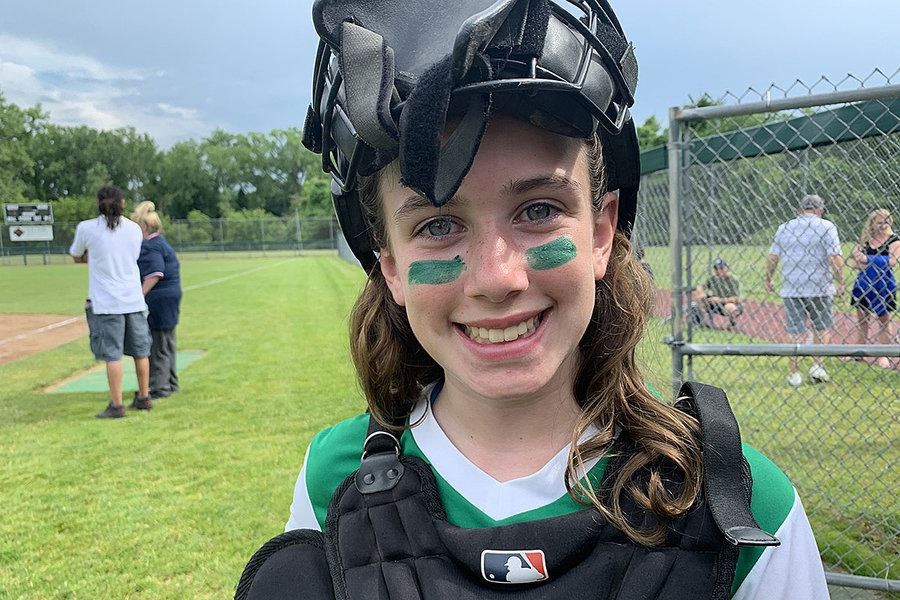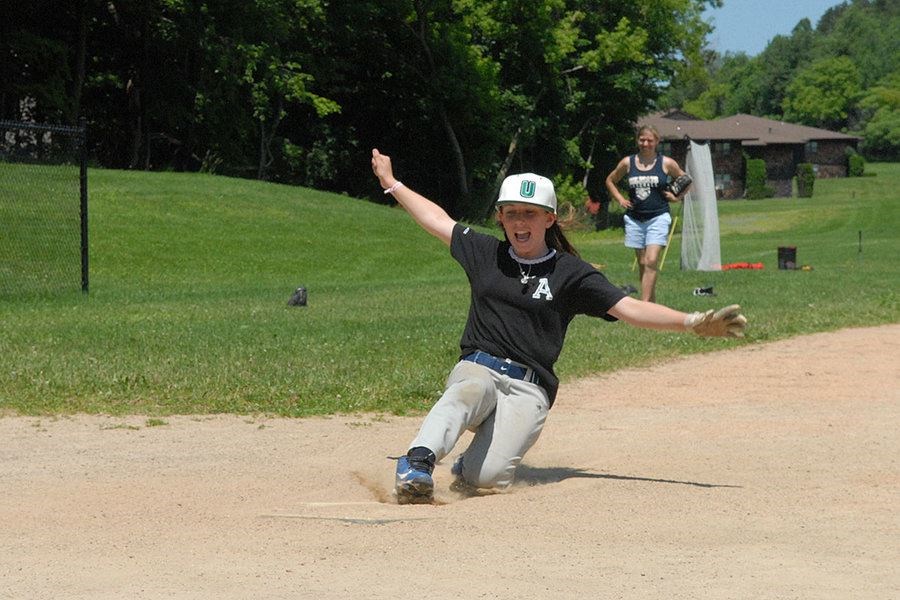Reprinted with permission from The Christian Science Monitor
Who should have the opportunity to make a career out of baseball? As more young women take to the field, observers say the question of equality needs to go beyond who will be the first to break into the big leagues.
AUGUST 1, 2019 - CAMILLUS, N.Y. - For Sarah Domin, there’s no greater feeling than hitting a baseball.
The 11-year-old is used to holding her own as the only girl on the field with boys. She’s played since she was a toddler, and according to her father, Hank, she has the highest batting average on her coed travel team. Even so, she sometimes has to answer questions about why she doesn’t play softball.
 Catcher and cleanup hitter Sarah Domin smiles for a photo during the Upstate New ork Boomers’ game against the Boston Slammers in Pittsfield, Massachusetts, on July 6. Sarah and her family started the Boomers in April.Courtesy of Hank Domin/The Upstate New York Boomers“Baseball is more fun,” she explains to those who ask.
Catcher and cleanup hitter Sarah Domin smiles for a photo during the Upstate New ork Boomers’ game against the Boston Slammers in Pittsfield, Massachusetts, on July 6. Sarah and her family started the Boomers in April.Courtesy of Hank Domin/The Upstate New York Boomers“Baseball is more fun,” she explains to those who ask.
This year, she and her family started a team just for girls in their area. When the Upstate New York Boomers held their first practice on a soggy field behind a Camillus elementary school in April, they became part of a growing movement to expand girls’ access to “America’s pastime.” Nine girls showed up at first. But as word spread, more arrived, with 40 players now filling out the group’s two teams.
Grassroots approaches like this are spreading across the United States at the same time the USA Baseball women’s national team competes in top tournaments internationally. With history showing a steady stream of women interested in playing the sport, observers say it’s time to update societal views about participation: Anyone who aspires to play should be able to.
“The media tends to ask whether a woman will play in MLB,” says Justine Siegal, founder of the nonprofit Baseball for All, which held the first all-girls national tournament in 2015. “But the better question is when will girls as young as 7 years old have full freedom to pursue a baseball career like the boys do?”
Baseball for All estimates that 100,000 girls play youth baseball every year, but just 1,762 girls played in the 2017-18 high school baseball season, according to the National Federation of State High School Associations. Many girls are pushed toward softball, which is billed as an alternative that provides similar opportunities, says Kat Williams, a historian at Marshall University in Huntington, West Virginia.
But the greater concern, she says, is the ability to play one’s sport of choice. “At its core, it’s about fairness and equal opportunity,” says Professor Williams, who founded the International Women’s Baseball Center to preserve women’s baseball history. “[It’s about] learning the lessons that the sport has taught boys for eons. It’s about leadership, healthy bodies, and believing in yourself.”
 Sarah Domin slides into home plate at an Upstate New York Boomers practice at East Hill Elementary School in Camillus, New York, June 23, 2019.Danny Jin/The Christian Science MonitorWomen have long demanded and created spaces in the sport, although exclusionary attitudes and practices have limited their participation. Vassar College fielded a women’s team as early as 1866. And the All-American Girls Professional Baseball League – immortalized in the film “A League of Their Own” – started in 1943. Women kept playing after the league disbanded in 1954.
Sarah Domin slides into home plate at an Upstate New York Boomers practice at East Hill Elementary School in Camillus, New York, June 23, 2019.Danny Jin/The Christian Science MonitorWomen have long demanded and created spaces in the sport, although exclusionary attitudes and practices have limited their participation. Vassar College fielded a women’s team as early as 1866. And the All-American Girls Professional Baseball League – immortalized in the film “A League of Their Own” – started in 1943. Women kept playing after the league disbanded in 1954.
The Boomers make a point of remembering history’s success stories. The team’s name is derived from “Bloomer Girls” teams that traveled the country to compete in the late 19th and early 20th centuries. For a school wax museum project that saw most students dress as George Washington or Abraham Lincoln, Sarah chose Maria Pepe, who in 1972 sued Little League for the right to play baseball, paving the way for girls’ participation for decades to come.
While media coverage sometimes treats high-achieving girls and women in baseball as anomalies, they are more common than people expect, says Kent State historian Leslie Heaphy. “These are stories the vast majority of people don’t know, but they aren’t exceptions,” she says.
Ms. Siegal, who became the first woman to coach for an MLB team in 2015, worked with local volunteers to help 11 communities create teams to play in the first Baseball for All national tournament in the same year. A 12th team came from Toronto’s Royal York Baseball League. Afterward, girls around the U.S. started their own teams. This year’s tournament, which started on Wednesday, includes 31 teams.
Ashlynn Jolicoeur, age 8, will be one of the more than 350 girls participating. She has said she dreams of someday suiting up for Team Canada. A video tweeted in July by Baseball for All showing Ashlynn making diving catches has garnered nearly 5 million views on Twitter. ESPN posted the video to its Facebook page and it is up to almost 11 million views.
As more girls take the field, they also have more places to look for inspiration and support.
The USA Baseball women’s national team began in 2004 and won gold at the Women’s Baseball World Cup in 2004 and 2006, the first two years the event was held.
Team USA captain Malaika Underwood, who joined in 2006, sees herself uniquely positioned to help young players. National team players provide mentorship through programs recently started by USA Baseball and MLB, whose increased focus on inclusion could help raise awareness, experts say.
“I looked up to what few role models I had,” Ms. Underwood says. “I never forget what those women contributed to my career. The path isn’t a clear one, but we all find a way to stay in the sport because we all have a passion for it.”
A professional women’s league is the next step for creating opportunities, Professor Williams says. Such leagues exist in several countries, including Japan, which has won the past six World Cup titles. High schools and colleges could also expand access by offering girls’ and women’s baseball, Ms. Siegal says.
“We’re sort of at a tipping point” with acceptance, adds Ms. Underwood. She looks forward to a time when she can tell people she plays for the USA Baseball women’s national team and they won’t correct her and say, “You mean softball, right?”
Get the Monitor Stories you care about delivered to your inbox.
Sarah hopes the Boomers can play a small part in that change of thought.
“I just want girls to be happy and comfortable and confident about themselves,” she says.
Page created on 8/5/2019 5:16:44 PM
Last edited 8/5/2019 5:26:32 PM
